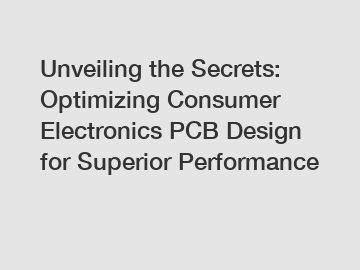Unveiling the Secrets: Optimizing Consumer Electronics PCB Design for Superior Performance
Unveiling the Secrets: Optimizing Consumer Electronics PCB Design for Superior Performance.
In the fast-paced world of consumer electronics, manufacturers are constantly striving to improve the performance and functionality of their products. Behind the sleek designs and advanced features lies a crucial component known as the printed circuit board (PCB). Often overlooked, the PCB plays a vital role in determining the overall performance and reliability of a consumer electronic device. In this article, we will delve into the secrets of optimizing consumer electronics PCB design for superior performance, uncovering the key factors that can make a significant difference in the end product.
Choosing the Right PCB Materials.

Selecting the appropriate materials for the PCB is paramount to achieving optimum performance. Factors such as dielectric constant, dissipation factor, and thermal conductivity should be considered to ensure signal integrity, electrical stability, and heat dissipation. Advanced materials such as FR-4 with high Tg (glass transition temperature) are commonly used for consumer electronics, as they provide excellent mechanical strength, good thermal stability, and low moisture absorption.
Optimizing Layout and Signal Integrity.
The layout of a PCB is another critical aspect that can greatly impact the performance of consumer electronics. By carefully considering factors such as component placement, routing, and ground plane design, engineers can optimize signal integrity, minimize electromagnetic interference (EMI), and achieve efficient heat dissipation. Utilizing techniques like differential pair routing and impedance control can further enhance signal quality and reduce crosstalk, ensuring superior performance.
Minimizing Power Consumption.
For portable consumer electronic devices, minimizing power consumption is of utmost importance. PCB design plays a crucial role in achieving optimal power efficiency. By employing techniques such as power gating, voltage regulation, and careful component selection, engineers can reduce power leakage and extend battery life. Smart power management solutions and low-power components also contribute significantly to enhancing the end-user experience.
Thermal Management for Reliability.
Consumer electronic devices often generate substantial amounts of heat during operation. Failure to effectively manage heat can lead to system instability, reduced lifespan, and compromised performance. Incorporating thermal vias, heat sinks, and proper airflow design into the PCB ensures efficient heat dissipation, preventing overheating. Advanced thermal analysis tools help identify hotspots and optimize cooling solutions, improving reliability and overall performance.
Testing and Assurance.
To deliver high-quality consumer electronic devices, thorough testing and assurance processes are essential. PCB design verification, validation, and testing should be integrated into the development cycle to identify and rectify potential issues early on. Advanced testing methodologies, such as boundary scan testing and automated optical inspection, provide comprehensive assessment and validation of the PCB assembly, ensuring superior performance and reliability.
Conclusion.
Optimizing consumer electronics PCB design is an intricate process that requires careful consideration of several factors. Selecting appropriate materials, optimizing layout and signal integrity, minimizing power consumption, implementing effective thermal management, and conducting rigorous testing are all critical steps towards achieving superior performance. By focusing on these aspects, manufacturers can deliver high-quality, efficient, and reliable consumer electronic devices that meet the demands of today's tech-savvy consumers.
For further assistance with consumer electronics PCB design and optimization, feel free to contact us. Our team of experts is well-equipped to provide customized solutions and support to meet your specific requirements.
If you want to learn more, please visit our website industrial control pcb , industrial control pcb , consumer electronics pcb .

Comments
0